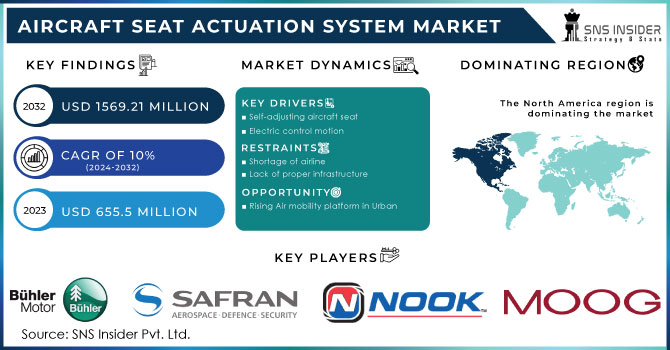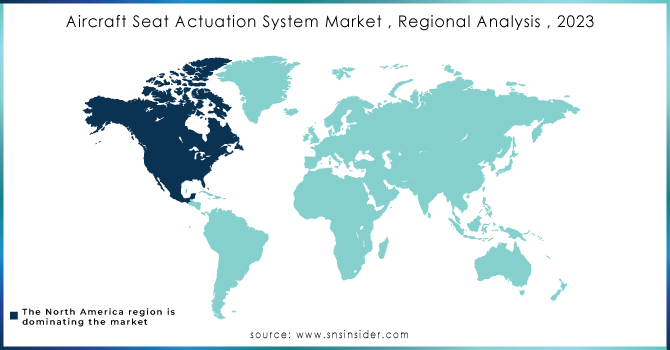Aircraft Seat Actuation System Market Report Scope & Overview:

To get more information on Aircraft Seat Actuation System Market - Request Free Sample Report
The Aircraft Seat Actuation System Market Size was valued at USD 655.5 million in 2023 and is expected to reach USD 1569.21 million by 2032 with a growing CAGR of 10% over the forecast period 2024-2032.
Actuators are devices that translate electronic signals into mechanical movement. The seat actuation mechanism in aircrafts allows passengers to alter their seating position to their preference. Seats are motorized and moveable between several seating positions based on the needs of the occupants. Seats, for example, can be adjusted from an upright to a reclined posture, or totally reclined to a flat position and function as a bed. Passengers can also modify environmental factors around their seat, such as lighting and temperature, using aircraft seat actuation systems. Passengers can also employ other functions linked with the aircraft seat actuation system, such as the display screen for watching movies and changing the head rest and foot rest. Commercial and private aircrafts both employ aircraft seat actuation systems.
The Aircraft seat actuation system provides comfort and safety to the passengers and pilot on board. They aid in the optimization of the seat, allowing passengers to sit in a variety of positions. The increase in middle-class families' disposable income allows them to purchase superior services and frequent air travel activities, reducing exertion and the length of time spent going from one location to another. Leading authorities throughout the world are boosting their respective countries' tourism and hospitality businesses in order to generate additional cash and enhance their economies. In the future years, the Aircraft Seat Actuation System Market will expand due to an increase in the number of market participants participating in commercial aviation, as well as the adoption of quality aircraft and premium services are components to attract more passengers.
MARKET DYNAMICS
KEY DRIVERS
-
Self-adjusting aircraft seat
-
Electric control motion
RESTRAINTS
-
Shortage of airline
-
Lack of proper infrastructure
OPPORTUNITIES
-
Rising Air mobility platform in Urban
CHALLENGES
-
Rising capacity demand
-
Reduce aircraft weight
IMPACT OF COVID-19
Due to the nature of the COVID-19, the production of pneumatic seat actuation systems worldwide, has been disrupted due to announced closures and government travel restrictions. The supply of aircraft system parts for pneumatic seat seats such as electronic components, brake brakes had a negative impact due to COVID-19.
Government restrictions on travel due to COVID-19, have negatively impacted the need for new and commercially commercial airlines. As such, the market growth of the pneumatic seat actuation system has also had a negative impact. Demand for aircraft pneumatic seat actuation is expected to rise soon as travel restrictions begin to loosen in some parts of the world. The need for spare parts such as sensors, and electronic devices is also low as there is no need as many aviation businesses have been shut down due to the COVID-19 epidemic.
The market is divided into four seat classes: Premium Economy, First Class, Economy Class, and Business. Due to a rise in aircraft orders with more business class and increased desire for enhanced customer experience globally, business class has the largest section of the aircraft seat actuation system market. The electromechanical area is predicted to be the most valuable market. The deployment of electromechanical actuation systems for both linear and rotational mechanisms has contributed to the expansion of the electromechanical section of the aircraft seat actuation system market.
The OEM sector is expected to have the highest CAGR rate in the aircraft seat actuation system market throughout the forecast period. The rising need for customized aircraft that are fitted with various components, as retrofitting older aircraft is a time-consuming procedure for airlines, might be linked to the expansion of the OEM section of the aircraft seat actuation system market. The market is divided into three types: hydraulic, electro-mechanical, and others. The electro-mechanical sector has the largest market share, which is likely to grow further throughout the forecast period. Electro-mechanical is the most recent technology, and it is both cost-effective and long-lasting. The market is divided into three categories: hardware, software, and other components. During the projected period, the hardware segment is expected to lead the aeroplane seat actuation system market. The hardware component of this industry is being driven by the increase in commercial aircraft supplying a substantial share of economy class and premium economy class seats.
KEY MARKET SEGMENTATION
By Type
-
Electro-mechanical
-
Pneumatic
-
Hydraulic
By End User
-
OEM
-
Aftermarket
By Aircraft Type
-
Narrow Body Aircraft
-
Wide Body Aircraft
-
Very Large Aircraft
-
Regional Transport Aircraft
-
Business Jets
By Seat Class
-
Premium Economy
-
First Class
By Mechanism
-
Linear
-
Rotary
By Component
-
Hardware
-
Software
REGIONAL ANALYSIS
During the forecast period, North America is expected to have the biggest regional share of the aeroplane seat actuation system market. The primary factor responsible for North America leading the aeroplane seat actuation system market is the region's rapid development of technologically superior seating systems. The increasing usage of technology in aircraft creates various opportunities for makers of aircraft seating technology. North America is home to leading aircraft manufacturers such as The Boeing Company and Bombardier, as well as key aviation system and component manufacturers such as Collins Aerospace, Aptronics Corporation, ITT Inc., and Crane Co. Some of the largest commercial airlines by fleet size have their headquarters in the region, including American Airlines Group, Delta Air Lines, Inc., and United Airlines.

Need any customization research on Aircraft Seat Actuation System Market - Enquiry Now
REGIONAL COVERAGE:
-
North America
-
USA
-
Canada
-
Mexico
-
-
Europe
-
Germany
-
UK
-
France
-
Italy
-
Spain
-
The Netherlands
-
Rest of Europe
-
-
Asia-Pacific
-
Japan
-
south Korea
-
China
-
India
-
Australia
-
Rest of Asia-Pacific
-
-
The Middle East & Africa
-
Israel
-
UAE
-
South Africa
-
Rest of Middle East & Africa
-
-
Latin America
-
Brazil
-
Argentina
-
Rest of Latin America
-
KEY PLAYERS
The Major Players are Bühler Motor GmbH, Safran, NOOK Industries INC., Moog Inc., Rollon S.p.A., Kyntronics, Astronics Corporation., ITT INC., Airworks Inc., CRANE AEROSPACE & ELECTRONICS, and other players
| Report Attributes | Details |
|---|---|
| Market Size in 2023 | US$ 655.5 Million |
| Market Size by 2032 | US$ 1569.21 Million |
| CAGR | CAGR of 10% From 2024 to 2032 |
| Base Year | 2023 |
| Forecast Period | 2024-2032 |
| Historical Data | 2020-2022 |
| Report Scope & Coverage | Market Size, Segments Analysis, Competitive Landscape, Regional Analysis, DROC & SWOT Analysis, Forecast Outlook |
| Key Segments | • By Type (Electro-mechanical, Pneumatic, Hydraulic) • By Mechanism (Linear and Rotary) • By End User (OEM, Aftermarket) • By Aircraft Type (Narrow Body Aircraft, Wide Body Aircraft, Very Large Aircraft, Regional Transport Aircraft, and Business Jets) • By Seat Class (Premium Economy, First Class) • By Component (Hardware and Software) |
| Regional Analysis/Coverage | North America (USA, Canada, Mexico), Europe (Germany, UK, France, Italy, Spain, Netherlands, Rest of Europe), Asia-Pacific (Japan, South Korea, China, India, Australia, Rest of Asia-Pacific), The Middle East & Africa (Israel, UAE, South Africa, Rest of Middle East & Africa), Latin America (Brazil, Argentina, Rest of Latin America) |
| Company Profiles | Bühler Motor GmbH, Safran, NOOK Industries INC., Moog Inc., Rollon S.p.A., Kyntronics, Astronics Corporation., ITT INC., Airworks Inc., CRANE AEROSPACE & ELECTRONICS, and other players. |
| DRIVERS | • Self-adjusting aircraft seat • Electric control motion |
| RESTRAINTS | • Shortage of airline • Lack of proper infrastructure |

